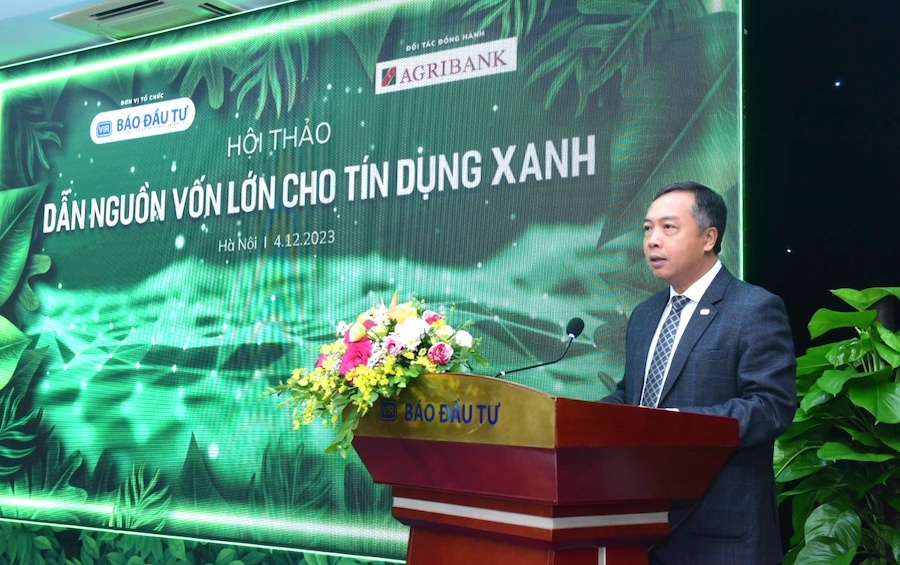Vietnam's green credit surge: Navigating towards sustainable finance
 |
VIR editor-in-chief Le Trong Minh underscored the global shift towards sustainability in his keynote address.
"The current global situation, compounded by the challenges of climate change, necessitates a swift transition to sustainable and inclusive growth models," Minh stated, reaffirming Vietnam's commitment to this global trend.
In Vietnam, green growth and sustainable development are deeply intertwined within the nation's socioeconomic development strategy.
As Minh stated, "Vietnam's pursuit of green growth is not just a policy stance but a reflection of our commitment as responsible global citizens."
Vietnam's role in the international climate change dialogue is significant, given its participation in the United Nations Framework Convention on Climate Change and its vulnerability to climate impacts.
Since COP26, Vietnam has been proactive in deploying strategies to achieve its net-zero emissions goal by 2050, a commitment that was reiterated at COP27 and highlighted at the ongoing COP28 in the United Arab Emirates.
Highlighting the challenges of a developing nation like Vietnam, Minh acknowledged, "Our commitments to climate change mitigation are as robust as those of developed countries, demonstrating our government's resolve towards inclusive, green, and sustainable development."
This firmness of purpose is mirrored in the National Strategy for Green Growth 2021-2030 and the National Action Plan for Green Growth 2021-2030, both endorsed by Prime Minister Pham Minh Chinh.
However, the path to realising these ambitions is resource intensive.
The World Bank estimates that Vietnam requires approximately $15.5 billion annually, equivalent to 6.8 per cent of its GDP, to align with resilient net-zero development by 2040.
Public sector funding falls short in meeting these demands, necessitating an additional $6.1 billion or 2.2 per cent of GDP, as reported by the Ministry of Planning and Investment.
Minh emphasised the complexity of resource mobilisation for a transitioning, lower-middle-income country like Vietnam. "Green finance, especially green credit, has emerged as a pivotal solution in this scenario," he noted.
The green credit sector in Vietnam, growing at an average rate of about 23 per cent from 2017-2022, demonstrates a higher growth trajectory compared to the national average.
This surge is driven by businesses increasingly complying with environmental, social, and governance standards, boosting the demand for green credit. Government initiatives and regulations, including Directive No.03/CT-NHNN and Circular No.17/2022/TT-NHNN, further bolster this sector.
"Despite the encouraging growth, the current green credit volume of approximately $25.3 billion signals a yet untapped potential in this domain," the editor-in-chief remarked.
He sees both domestic banks and international partners as key players in harnessing this potential.
Minh raised crucial questions for the seminar's agenda, including identifying the challenges in mobilising large capital sources, refining legal frameworks, and generating solutions to enhance domestic green credit flows.
"These discussions are fundamental to advancing Vietnam's green credit sector and meeting the growing demand," he concluded.
 | Green finance must be unlocked to develop The banking sector has been urged to unlock viable green finance to attract a broader investor base to facilitate its green transition. |
 | Positive signs in Vietnam's green credit sector 'Green credit' refers to the kinds of loans provided by banks for projects that are considered environmentally friendly or protective of the ecosystem. Green credit is now a trend in the global banking and finance industry, and more Vietnamese banks are following suit. |
What the stars mean:
★ Poor ★ ★ Promising ★★★ Good ★★★★ Very good ★★★★★ Exceptional
 Tag:
Tag:
Related Contents
Latest News
More News
- As global green supply chain reshapes, will Vietnam be left behind? (December 19, 2025 | 08:00)
- Banks gear up for massive capital increases (December 18, 2025 | 17:04)
- Securing capital and efficiency for Vietnam’s 2026-2030 growth ambitions (December 17, 2025 | 10:00)
- Energy sector in need of blended finance mechanisms (December 17, 2025 | 09:00)
- Vietnam still has room to mobilise capital for sustainable growth (December 17, 2025 | 08:57)
- Long-term capital seen as key hurdle to green growth (December 16, 2025 | 08:00)
- Gold prices swing amid tax debate and import uncertainty (December 15, 2025 | 18:04)
- Agribank frames bank credit as catalyst for green growth (December 15, 2025 | 17:59)
- Vietnam’s green transition demands collective financial action (December 15, 2025 | 12:00)
- VIR workshop highlights capital and policy for sustainable development (December 15, 2025 | 11:00)























 Mobile Version
Mobile Version